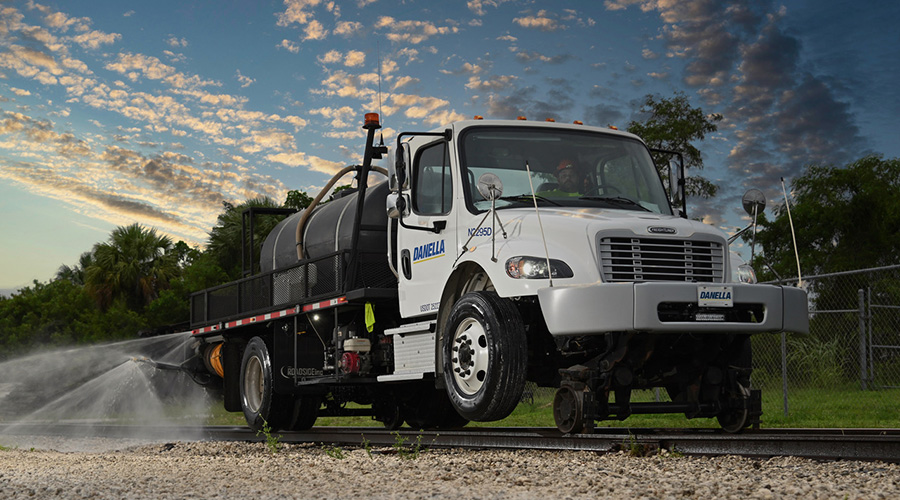Stay updated on news, articles and information for the rail industry
April 2011
Rail News: MOW
Maintenance of Way: NRC and contractor safety
by Julie Sneider, Assistant Editor
Safety on the job starts with a well-trained worker.
That's the idea behind the National Railroad Construction and Maintenance Association Inc.'s (NRC) effort to provide NRC members with the educational resources and materials they need to make sure roadway workers are properly trained in on-track safety procedures.
NRC's resources include a DVD series designed to address contractors' primary safety concerns; online Roadway Worker Protection (RWP) training to meet Federal Railroad Administration (FRA) safety regulation; a bound, pocket-size guide of safety practices for railroad construction workers; and a series of 104 "Tool Box Talks" on safety practices to be discussed at a construction work site. Tool Box Talk topics range from personal health and safety precautions to safe practices on any type of construction site to railroad-specific issues, such as unloading rail cars or removing rail spikes without causing injury.
The educational materials may be incorporated into railroads' and contractors' training programs, says NRC President Chuck Baker.
Unveiled in January 2007, the DVDs in particular have been popular with NRC members, Baker says. Segments tackle topics of interest as determined annually by the NRC Safety Committee, which produces two new DVDs per year; so far, 10 in all.
"They're great materials for new hires, and they're also good reminders and updates for veteran workers," Baker says.
The segments cover subjects such as proper use of railroad hand and power tools; safety on freight and industrial track; safety around field welds, railway maintenance equipment, thermal adjusting continuous-welded rail (CWR), transit track and hot work; and safety while unloading material.
About 250 DVD copies are distributed annually at no cost to NRC members at the association's annual meeting.
Led by Stanley Beaver and John Zuspan, the NRC Safety Committee comes up with the DVD topics based on questions and concerns that NRC members raise during the year.
"We have a mile-long list of topic requests from contractors," says Zuspan, who also is founder and president of Track Guy Consultants, which provides railroad track construction training and inspection services.
Some segments focus on specific tasks and situations. For instance, one of last year's episodes reviewed safety procedures associated with thermal adjusting of CWR; this year, Zuspan and Beaver are thinking of producing a segment on how to prevent workers from tripping or falling on the job.
"The subject of slips, trips and falls is something we're going to have to do because a lot of [members] are concerned about these kinds of injuries on the work site," Zuspan says. "We'll probably meld that issue into the topic of replacing rail and ties."
After the NRC's Safety Committee and full board approves a DVD topic, Zuspan gets to work writing scripts, organizing a professional film crew and locating contractors willing to have their workers filmed while out in the field.
Ensuring Accuracy
The NRC Safety Committee reviews and approves the DVD-making process along the way, from script writing through film production, to ensure an accurate portrayal of safety standards and procedures, Zuspan says.
"These [DVDs] are very good at showing workers how to perform their job, whether they're running a chain saw or operating a piece of equipment, or working on overhead catenary systems," says Beaver. "They are specifically designed to have the worker perform the task without the worker being injured."
If the anecdotal feedback from NRC members is any indication, the DVDs are making a difference in railroad contractors' safety programs, Zuspan says. From what he hears, "people are working safer, and that's rewarding," he says.
Also part of NRC's efforts to promote a safe working environment is its online overview of FRA's RWP regulation. The FRA requires railroads and/or their contractors to provide RWP training to any worker whose job duties include inspection, construction, maintenance or repair of track, bridges, roadway, signal and communication systems, electric traction systems, roadway facilities or maintenance machinery on or near the track.
To assist members in meeting that requirement, the NRC developed an online RWP training program that's free to NRC members. The program has been approved by the FRA.
Contractors may adopt the NRC's RWP as their own training program, but Baker notes that the NRC program content is "generic" in that it's not specific to one particular railroad. Although RWP is mandated by federal regulation, each railroad handles RWP training and oversight in its own way. As a result, contractors have to make sure their employees also undergo the host railroad's safety training program and any other site-specific, on-the-spot training the railroad requires.
Currently, the FRA doesn't require roadway workers to complete a formal, standardized safety-training certification program, but the federal agency may be moving in that direction. The FRA is considering new rulemaking that would mandate minimum safety training standards that anyone doing any type of rail maintenance work would have to comply with, Baker says.
When the FRA rulemaking is ready, the NRC will "play an important role in developing an industry-wide template that contractors can adapt to their own circumstances," he says.


 2025 MOW Spending Report: Passenger-rail programs
2025 MOW Spending Report: Passenger-rail programs
 Gardner steps down as Amtrak CEO
Gardner steps down as Amtrak CEO
 Guest comment: Oliver Wyman’s David Hunt
Guest comment: Oliver Wyman’s David Hunt
 Women of Influence in Rail eBook
Women of Influence in Rail eBook
 railPrime
railPrime







